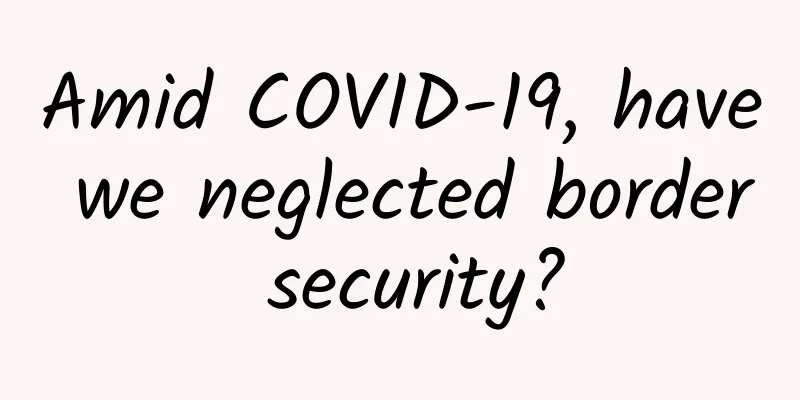Amid COVID-19, have we neglected border security?

|
The coronavirus pandemic has triggered an unprecedented chain reaction of border closures around the world. Even among the 26 countries in the Schengen area, most have reinstated border controls in an effort to stop the virus. The Schengen Area refers to the area formed by 26 European countries that implement the Schengen Agreement signed in the town of Schengen in Luxembourg in 1985. For international travelers, this area is very much like a single country, with almost no border controls between countries in the area and free entry and exit. Reactivating border infrastructure So when the pandemic hit, governments suddenly found themselves under enormous pressure as they struggled to hastily reapply border infrastructure that had not existed in any practical operational sense for decades. However, this is not just an EU problem. This is truly a unique situation, with many other countries also struggling with a lack of information, resources and coordination between the relevant agencies and authorities. These operational issues raise questions around the world: Are border controls effective in containing such outbreaks? How can border agencies prepare for emergencies? What does this mean for border management in a post-pandemic world? Divert attention There is no doubt about it: COVID-19 is a public health wake-up call. However, with all efforts focused on stopping the spread of the virus, many countries have been sitting back while dealing with other security issues, such as internal terrorism and drug trafficking. Many high-risk facilities, such as airports, nuclear power plants, and military bases, have stopped installing important security systems due to reduced budgets, staffing, and time issues. Without the right systems, these critical facilities are vulnerable to attacks and smuggling. As airlines cancel flights at the last minute amid fears of the health risks of air travel, more people are also choosing to drive over the holidays – which means tighter security measures at borders for civilians travelling between countries. But while border officials have been directing vehicles and passengers to specialists responsible for on-site medical screening, other border control checks have been relaxed. Increased drug trade Perhaps most worrying, but not entirely surprising, is that organized crime groups have remained active and resilient throughout the pandemic. While the pandemic has slowed economic growth in almost every other region, this economic trend has not been seen in international drug trafficking, which continues to generate huge profits. In fact, in the first half of 2020, some EU countries made more illegal drug seizures than in the same period of previous years. With social distancing measures in place and severe restrictions on movement, drug traffickers have turned to alternative methods, such as social media platforms and encrypted communication apps. But while the logistics may have changed, the movement of large quantities of drugs has not ceased. The continued commercial movement of goods despite border controls means that the drug trade remains rife, with operations continuing along many known routes, such as the Balkan highway often used for heroin trafficking. Accelerate the pace Security needs to move forward, especially at a faster pace in the post-pandemic era. It is particularly important that terrorists and organized crime groups do not benefit from the consequences of the current crisis. Recovery from the pandemic therefore needs to be accompanied by a robust and effective response to security in everything from drug trafficking to terrorism. But what does this mean for border controls, both external borders and physical borders at critical facilities? The coronavirus pandemic has highlighted gaps in existing arrangements and challenged existing systems, demonstrating the need to be able to quickly adapt and re-impose physical barriers and other controls where necessary. If the pandemic has demonstrated anything, it is that careful coordination is needed between all border agencies to ensure that security measures are effective. Increasing screening of people, vehicles and goods crossing national borders will not solve security problems without further measures within each country. Sharing information across borders, including threat perception and risk analysis, is also critical. Security systems such as X-ray inspection equipment can then help reinforce these coordinated efforts - providing border agencies with needed backup, especially when resources are low and time is of the essence. For example, they can quickly and easily detect contraband such as drugs, explosives or weapons. Mobile solutions can also be quickly deployed anywhere, anytime to add an extra layer of physical security. |
<<: How edge computing and 5G can drive business applications
>>: Kerlink and Radio Bridge provide LoRaWAN solutions for private IoT networks
Recommend
Understanding HTTP and TCP protocols from an HTTP request
[[347384]] From an HTTP request to see the princi...
How does network automation simplify network operations?
In today's rapidly evolving digital environme...
How is HostYun? Simple test of HostYun Hong Kong EPYC high bandwidth VPS
A few days ago, we shared the information that Ho...
DesiVPS: $15/year KVM-1GB/15GB/2.5TB/Los Angeles & Netherlands Data Center
Tribe shared information about DesiVPS last year....
[Closed] Arkecx 40% off, Hong Kong/Taiwan/Japan/Korea/USA etc. starting from $72/year
[Updated in August 2023] Please note that the off...
Zhang Hao from Ele.me: A food delivery guy sent by AI
[51CTO.com original article] On July 21-22, 2017,...
Who is responsible for the rampant online black industry?
[[188973]] A set of data: According to the 38th &...
The future of high-speed connectivity: Embedded non-volatile memory in 5G networks
In the fast-paced world of technology, the demand...
Ruijie Cloud Desktop supports Beijing's COVID-19 fight
Imported from abroad, confirmed locally, the sudd...
Aruba: New working modes bring huge challenges that traditional network infrastructure cannot cope with
Recently, with the improvement of this round of e...
In the first month of Alipay’s digital shopping mall launch, 80% of the country’s top shopping malls have opened Alipay “offices”
Intime, Mixc, Impression City and Alipay jointly ...
zorocloud: US CN2 GIA line VPS monthly payment starts from 34 yuan, including DDoS protection
Zorocloud is a domestic hosting company that was ...
SiberDC: $1.3/month Türkiye VPS - dual core/1GB RAM/30G SSD/1Gbps unlimited traffic
SiberDC is a foreign merchant founded in 2011, he...
Can video ringtones become a phenomenal application in the 5G era?
The latest data: The number of video ringtone use...
Computer software: Recommend 10 practical office efficiency tools
[[395494]] 1. Everything search tool Everything i...









